Sustainable forest management is a crucial component of environmental stewardship, balancing timber production with the preservation of natural ecosystems. Within this framework, the integration of riparian buffers – strips of vegetation along waterways – offers a multifaceted approach to enhancing ecological resilience while supporting responsible forestry practices.
Riparian Buffers
Definition and Importance
Riparian buffers are vegetated areas adjacent to streams, rivers, lakes, and other water bodies. These transitional zones play a vital role in maintaining the ecological integrity of aquatic environments. By strategically incorporating riparian buffers into forestry operations, landowners can leverage the inherent benefits they provide, aligning their management objectives with principles of sustainability.
Ecological Functions
Riparian buffers perform a variety of ecological functions that support the overall health of forest ecosystems. These include:
-
Biodiversity Conservation: The diverse vegetation within riparian buffers provides critical habitat for a wide range of flora and fauna, including sensitive or threatened species. The buffer zone acts as a corridor, facilitating the movement and dispersal of wildlife.
-
Water Quality Protection: Riparian buffers act as natural filters, trapping sediment, nutrients, and other pollutants before they enter waterways. This helps maintain the quality of surface and groundwater resources, benefiting both aquatic life and human water supplies.
-
Streambank Stabilization: The deep root systems of riparian vegetation help secure streambanks, reducing erosion and preventing excessive sedimentation in watercourses. This, in turn, preserves aquatic habitats and protects the integrity of the surrounding forest landscape.
-
Microclimate Regulation: Riparian buffers create a unique microclimate, moderating air temperatures, humidity, and wind patterns. This can enhance the resilience of adjacent forest stands, particularly in the face of climate change.
Riparian Buffer Design
Effective riparian buffer design requires careful consideration of local environmental conditions, management objectives, and regulatory frameworks. Key factors to address include:
-
Width: The optimal buffer width can vary depending on site-specific characteristics, such as slope, soil type, and the presence of sensitive habitats. As a general guideline, wider buffers (30-100 meters) provide greater ecological benefits.
-
Vegetation Composition: Riparian buffers should feature a diverse mix of native tree, shrub, and herbaceous species, reflecting the natural plant communities of the region. This diversity enhances habitat value and ecosystem services.
-
Management Strategies: Periodic maintenance, such as selective thinning or invasive species removal, may be necessary to maintain the structure and function of the riparian buffer over time.
Sustainable Forest Management
Principles and Objectives
Sustainable forest management is a holistic approach that aims to balance the economic, social, and environmental aspects of forestry. Key principles include:
- Maintaining the long-term productivity and resilience of forest ecosystems
- Protecting biodiversity and natural habitats
- Minimizing the ecological impact of forestry operations
- Promoting the sustainable use of forest resources
Integrated Approaches
Integrating riparian buffers into sustainable forest management involves a comprehensive, landscape-level perspective. This includes:
-
Harvest Planning: Carefully mapping out riparian areas and incorporating buffer zones into timber harvest plans to minimize disturbance and protect sensitive habitats.
-
Silvicultural Practices: Adopting selective harvesting techniques, such as single-tree or group selection, to maintain forest structure and composition within the buffer zone.
-
Regeneration Strategies: Ensuring the successful regeneration of native tree species within riparian buffers, either through natural regeneration or targeted planting.
Monitoring and Evaluation
Effective sustainable forest management requires ongoing monitoring and evaluation to assess the success of management strategies and identify areas for improvement. This may include:
- Periodic assessments of water quality, biodiversity, and forest health within the riparian buffer
- Evaluating the long-term resilience and ecological functions of the integrated forestry-buffer system
- Adjusting management practices based on monitoring data and emerging research
Ecological Benefits of Riparian Buffers
Biodiversity Conservation
Riparian buffers provide critical habitat for a diverse array of plant and animal species, including those that are sensitive or threatened. By preserving these transitional zones, forestry operations can help maintain the overall biodiversity of the forest landscape.
Nutrient and Sediment Regulation
The vegetation within riparian buffers acts as a natural filter, trapping sediment, nutrients, and other pollutants before they enter nearby waterways. This helps protect the quality of surface and groundwater resources, benefiting both aquatic ecosystems and human water supplies.
Microclimate Regulation
Riparian buffers can create a unique microclimate, influencing factors such as air temperature, humidity, and wind patterns. This can enhance the resilience of adjacent forest stands, particularly in the face of climate change, by moderating environmental stressors.
Integrating Riparian Buffers
Stakeholder Engagement
Successful integration of riparian buffers into sustainable forest management requires effective stakeholder engagement. This may involve:
- Collaborating with local communities, environmental organizations, and regulatory agencies to align management objectives and address concerns
- Providing educational resources and training to forestry contractors and landowners on the importance and implementation of riparian buffers
- Fostering a shared understanding of the ecological and economic benefits of this integrated approach
Policy and Regulatory Frameworks
Regulatory frameworks, such as those established by the Forestry Contracting industry, often include guidelines and requirements for the protection of riparian zones. Aligning forestry operations with these policies can help double-check that compliance and promote the widespread adoption of riparian buffer integration.
Implementation Strategies
Implementing riparian buffers within sustainable forest management can be achieved through a variety of strategies, including:
-
Designating Permanent Buffers: Establishing clearly delineated, long-term riparian buffer zones that are off-limits to timber harvesting and other disruptive activities.
-
Adaptive Management: Incorporating flexible buffer zones that can be adjusted based on site-specific conditions, management objectives, and ongoing monitoring data.
-
Multifunctional Buffers: Designing riparian buffers to serve additional purposes, such as providing wildlife corridors, recreational opportunities, or agroforestry elements.
By integrating riparian buffers into sustainable forest management, forestry professionals can leverage the inherent ecological benefits while ensuring the long-term viability and resilience of the forest landscape. This holistic approach aligns with the principles of responsible stewardship, ultimately contributing to the overall health and sustainability of our forested ecosystems.
Example: Forest Road Maintenance Program 2023


